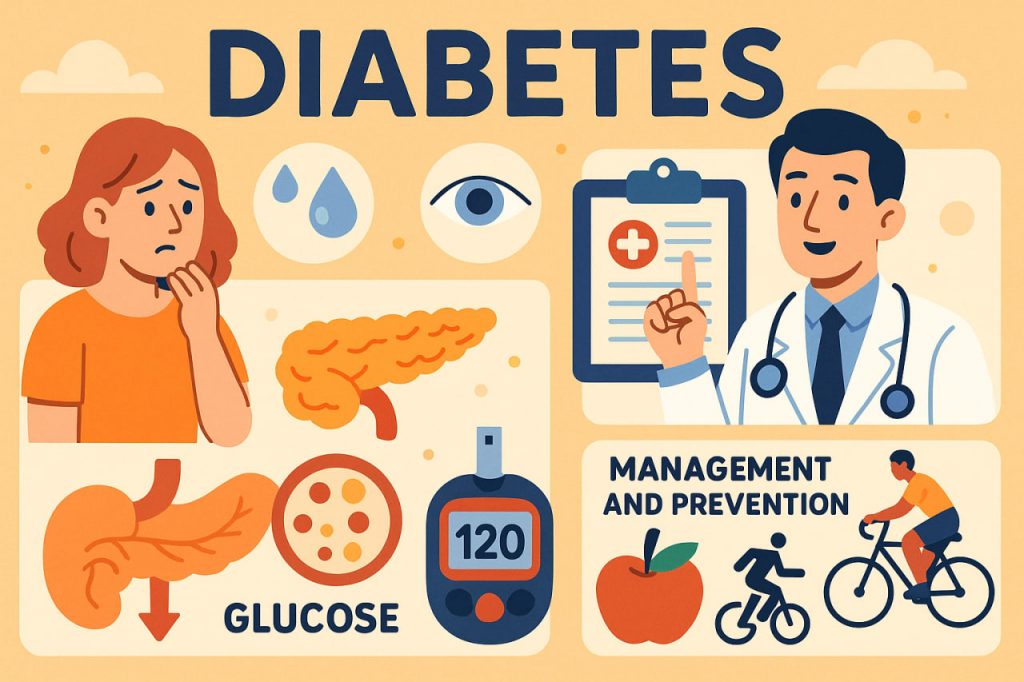Diabetes is a chronic metabolic disease that affects how the body processes blood sugar (glucose). Left unmanaged, it can lead to serious health complications. But with proper understanding and care, people with diabetes can live long, healthy lives.
What Is Diabetes?
Diabetes occurs when the body either doesn’t produce enough insulin or can’t use the insulin it produces effectively. Insulin is a hormone made by the pancreas that helps glucose from food enter the body’s cells, where it’s used for energy.
When glucose can’t enter the cells, it builds up in the blood, leading to high blood sugar levels. Over time, this can damage organs, nerves, and blood vessels.
There are three main types of diabetes:
- Type 1 Diabetes: An autoimmune condition where the pancreas produces little or no insulin. Usually diagnosed in childhood or adolescence.
- Type 2 Diabetes: A condition where the body becomes resistant to insulin or doesn’t produce enough. More common in adults but increasingly seen in children due to obesity.
- Gestational Diabetes: Develops during pregnancy and typically resolves after childbirth, but increases risk of type 2 diabetes later in life.
Signs and Symptoms
Common symptoms include:
- Frequent urination
- Excessive thirst
- Unexplained weight loss
- Fatigue
- Blurred vision
- Slow-healing wounds
- Increased hunger
Type 2 diabetes can develop gradually and may go unnoticed for years, which makes regular screening especially important for those at risk.
Risk Factors
Several factors can increase the risk of developing diabetes, especially type 2:
- Family history of diabetes
- Being overweight or obese
- Physical inactivity
- High blood pressure or cholesterol
- Poor diet high in sugar and processed foods
- Age over 45
- History of gestational diabetes
Why It’s Dangerous if Left Untreated
Without proper management, diabetes can lead to:
- Heart disease and stroke
- Kidney damage (diabetic nephropathy)
- Eye problems and blindness (diabetic retinopathy)
- Nerve damage (neuropathy)
- Foot complications, including amputations
- Increased risk of infections
These complications often progress silently, highlighting the importance of early detection and management.
Management and Prevention
While type 1 diabetes cannot be prevented, type 2 and gestational diabetes can often be delayed or prevented through lifestyle changes. If you are diagnosed with diabetes or are at risk, consult a healthcare professional to create a management plan that may include:
- Eating a balanced, low-sugar diet
- Regular physical activity
- Monitoring blood glucose levels
- Keeping a healthy weight
- Managing stress
- Quitting smoking
Your doctor may recommend medications or insulin therapy depending on your type of diabetes and overall health status.
Glossary
- Insulin – A hormone that helps move glucose from the bloodstream into cells.
- Glucose – A type of sugar that is the main energy source for the body’s cells.
- Metabolic disease – A disorder that affects how the body uses food and energy.
- Neuropathy – Nerve damage, often in the feet or hands, due to poor blood sugar control.
- Retinopathy – Eye damage caused by high blood sugar damaging the retina’s blood vessels.


